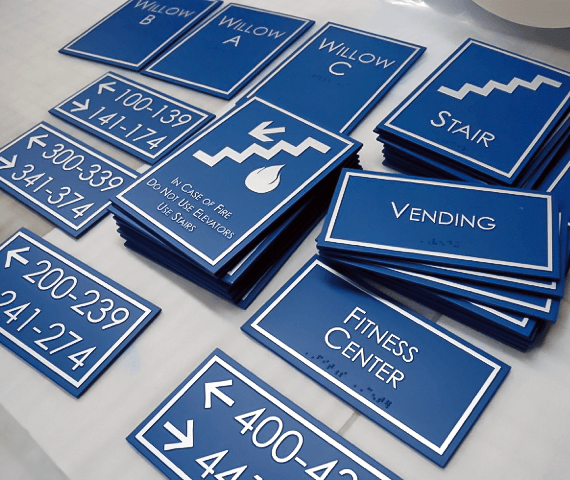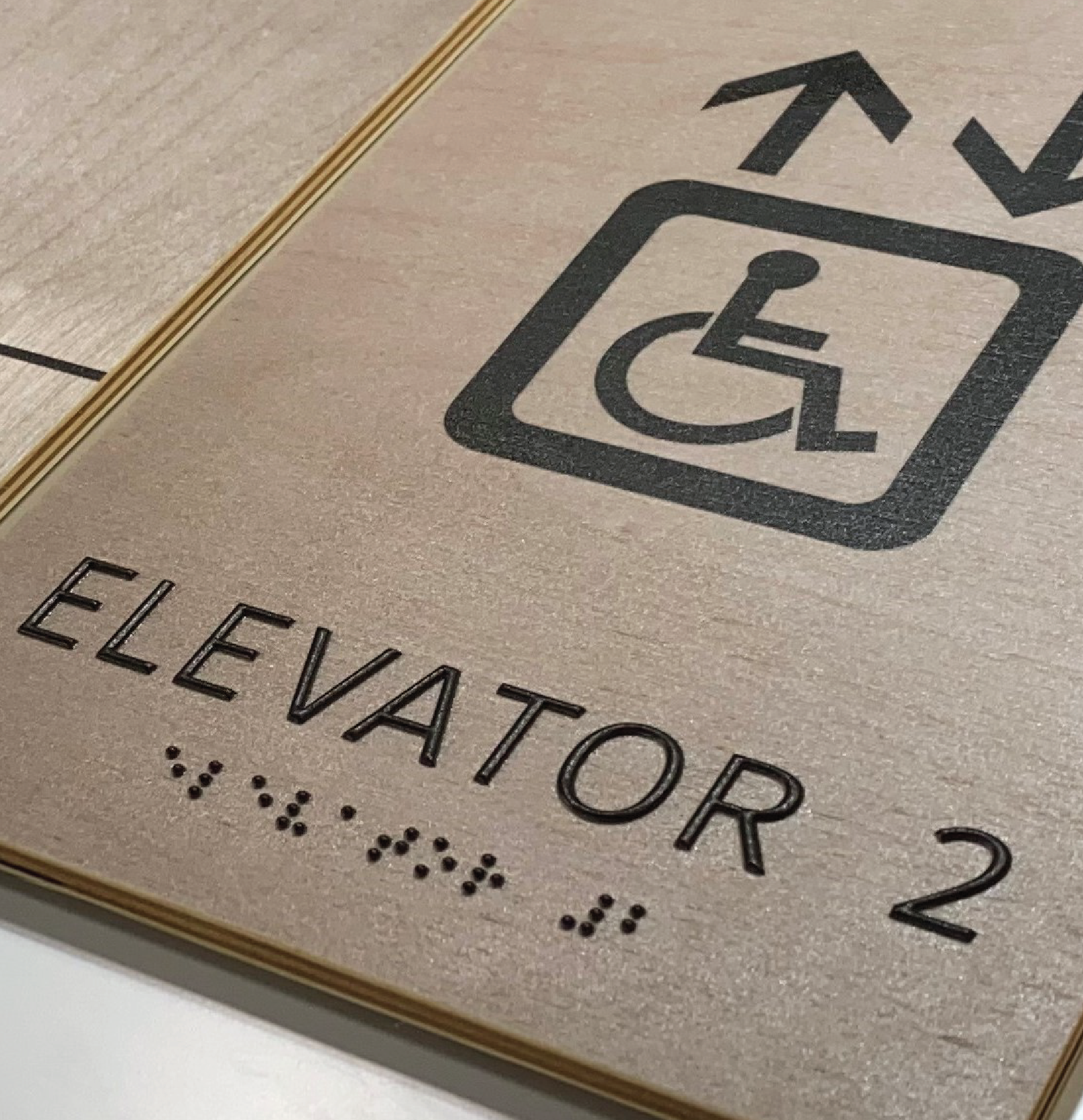A Comprehensive Guide to Picking the Right ADA Signs
A Comprehensive Guide to Picking the Right ADA Signs
Blog Article
Checking Out the Secret Functions of ADA Indications for Boosted Ease Of Access
In the world of accessibility, ADA indicators serve as quiet yet effective allies, ensuring that areas are inclusive and accessible for individuals with specials needs. By integrating Braille and tactile components, these indications damage barriers for the aesthetically damaged, while high-contrast shade schemes and understandable fonts provide to varied visual demands.
Significance of ADA Conformity
Ensuring compliance with the Americans with Disabilities Act (ADA) is important for fostering inclusivity and equivalent accessibility in public spaces and work environments. The ADA, established in 1990, mandates that all public facilities, companies, and transport services accommodate people with disabilities, ensuring they appreciate the same civil liberties and opportunities as others. Conformity with ADA criteria not just fulfills legal commitments but also improves an organization's track record by demonstrating its commitment to diversity and inclusivity.
One of the vital facets of ADA compliance is the application of easily accessible signs. ADA signs are made to ensure that individuals with specials needs can conveniently navigate via buildings and spaces.
Additionally, adhering to ADA regulations can minimize the threat of prospective penalties and legal effects. Organizations that stop working to follow ADA guidelines might deal with suits or charges, which can be both harmful and economically troublesome to their public image. Therefore, ADA conformity is important to promoting an equitable setting for everyone.
Braille and Tactile Aspects
The unification of Braille and responsive aspects into ADA signs embodies the concepts of access and inclusivity. It is commonly placed beneath the corresponding message on signs to make certain that individuals can access the details without aesthetic help.
Tactile components prolong beyond Braille and consist of elevated icons and personalities. These parts are designed to be noticeable by touch, allowing people to determine room numbers, restrooms, leaves, and other important areas. The ADA sets details standards relating to the size, spacing, and positioning of these responsive components to enhance readability and ensure uniformity across various atmospheres.

High-Contrast Color Design
High-contrast color design play a pivotal function in enhancing the exposure and readability of ADA signage for individuals with aesthetic impairments. These systems are crucial as they make the most of the difference in light reflectance in between message and history, making certain that signs are easily noticeable, even from a range. The Americans with Disabilities Act (ADA) mandates using details color contrasts to fit those with minimal vision, making it a crucial aspect of compliance.
The effectiveness of high-contrast colors lies in their capability to attract attention in various lights conditions, including dimly lit atmospheres and areas with glare. Commonly, dark message on a light background or light message on a dark history is employed to attain ideal comparison. For circumstances, black message on a white or yellow history gives a plain visual difference that aids in fast acknowledgment and comprehension.

Legible Fonts and Text Size
When taking into consideration the style of ADA signs, the selection of readable fonts and appropriate text dimension can not be overemphasized. The Americans with Disabilities Act (ADA) mandates that font styles have to be not italic and sans-serif, oblique, manuscript, very attractive, or of unusual kind.
According to ADA guidelines, the minimal message height ought to be 5/8 inch, and it must increase proportionally with watching range. Consistency in text dimension contributes to a natural aesthetic experience, assisting people in browsing environments effectively.
Moreover, spacing between letters and lines is essential to clarity. Adequate spacing protects against characters from appearing crowded, boosting readability. By sticking to these standards, designers can dramatically enhance ease of access, guaranteeing that signage serves its desired purpose for all individuals, no matter of their visual capacities.
Effective Positioning Techniques
Strategic placement of ADA signs is important for optimizing availability and guaranteeing compliance with lawful criteria. Appropriately positioned signs assist individuals with handicaps effectively, helping with navigating in public rooms. Trick factors to consider consist of distance, height, and presence. ADA standards specify that indications need to be installed at a height in between 48 to 60 inches from the ground to ensure they are within the line of view for both standing and seated people. This conventional elevation range is crucial for inclusivity, enabling mobility device users and individuals of varying elevations to accessibility information easily.
Furthermore, indications must be put adjacent to the latch side of doors to permit easy identification before access. This placement aids individuals locate rooms and rooms without blockage. In situations where there is no door, signs need to be located on the closest surrounding wall. Uniformity in sign placement throughout a facility improves predictability, lowering confusion and enhancing general user experience.

Verdict
ADA indicators play an important function in promoting availability by integrating functions that deal with the demands of individuals with impairments. Incorporating Braille and tactile aspects guarantees important info is obtainable to the aesthetically impaired, while high-contrast color design and legible sans-serif typefaces boost exposure across different lighting conditions. Efficient placement methods, such as appropriate placing heights and strategic areas, even more facilitate navigating. These elements collectively cultivate an inclusive atmosphere, underscoring the significance of ADA conformity in making sure equivalent gain access to for all.
In the world of access, ADA signs offer as i was reading this quiet yet effective allies, making certain that rooms are comprehensive and accessible for individuals with specials needs. The ADA, passed in 1990, mandates find here that all public facilities, companies, and transportation services suit individuals with impairments, guaranteeing they appreciate the very same legal rights and opportunities as others. ADA Signs. ADA indications are designed to make sure that people with disabilities can quickly browse via spaces and buildings. ADA standards stipulate that indicators ought to be installed at an elevation in between 48 to 60 inches from the ground to guarantee they are within the line of view for both standing and seated individuals.ADA indications play an essential function in promoting access by incorporating functions that address the demands of individuals with handicaps
Report this page